new posts in all blogs
Viewing: Blog Posts Tagged with: brazil, Most Recent at Top [Help]
Results 26 - 50 of 76
How to use this Page
You are viewing the most recent posts tagged with the words: brazil in the JacketFlap blog reader. What is a tag? Think of a tag as a keyword or category label. Tags can both help you find posts on JacketFlap.com as well as provide an easy way for you to "remember" and classify posts for later recall. Try adding a tag yourself by clicking "Add a tag" below a post's header. Scroll down through the list of Recent Posts in the left column and click on a post title that sounds interesting. You can view all posts from a specific blog by clicking the Blog name in the right column, or you can click a 'More Posts from this Blog' link in any individual post.

By: Alice,
on 6/18/2014
Blog:
OUPblog
(
Login to Add to MyJacketFlap)
JacketFlap tags:
Current Affairs,
brazil,
transportation,
FIFA,
*Featured,
amazônia,
Business & Economics,
stadiums,
Sports & Games,
Adam Grossman,
Developing Leaders,
High-Performance Industry,
Sports Strategist,
empty seats,
empty stadiums,
FIFA Fan Fests,
integrated place marketing strategy,
Irving Rein,
major sporting events,
marketing challenges,
World Cup 2014 Brazil,
gabriel_srsmith,
fests,
ainda,
construçao,
Books,
Add a tag
By Irving Rein and Adam Grossman
Stunning upsets. Dramatic finishes. Individual brilliance. Goals galore. The 2014 World Cup has started off with a bang. Yet, not as many people as expected are on hand to hear and see the excitement in venues throughout Brazil. Outside of the home country’s matches, there have been thousands of empty seats in stadiums throughout the tournament. Even marquee matchups, such as the Netherlands-Spain game, have failed to fill their venues. The Italian and English football associations each had 2,500 tickets allocated for their recent game. While England sold their entire allotment, Italy was reported to have returned hundreds of tickets back to FIFA.
So why is the world’s most popular sporting event playing to empty seats? Hosting the event in Brazil does create unique structural challenges that likely have and will prevent more sellouts. Because of the billions of dollars of public funds spent on the World Cup by Brazil, FIFA allocated a large number of tickets for exclusive purchase by fans from the host nation that are paying the bill. In a country where a 10-cent price increase in bus fare caused a nation-wide protest last year, paying $135-$188 dollars per match is likely too expensive for many Brazilian soccer fans.
However, the World Cup is not alone in having difficulty filling empty seats for major sporting events. For example, the National Football League (NFL) and the Southeastern Conference (SEC) are two of the most popular sports leagues in the United States. Yet, both organizations have seen declines in attendance over the past years and are spending significant resources in addressing this venue challenge. With ticket prices continually increasing and technology making it easing than ever to watch games on your television, laptop, or phone, how do sports organizations get people to come to venues?

Arena da Amazônia – Amazon Arena (Quando ainda em construçao – When still under construction.) Photo by Gabriel Smith. CC BY 2.0 via gabriel_srsmith Flickr.
The 2014 World Cup in Brazil demonstrates many of these issues. One of the biggest place marketing challenges is the location of the stadiums. Both FIFA and Brazil essentially used the Field of Dreams “if you build it they will come” strategy. Brazil decided to build or renovate 12 stadiums in many different parts of the country, including venues in remote locations throughout the country. For example, the United States’ second game will be held in Manaus in the Amazonian jungle. The city can only be reached by boat or plane as no highways connect the city to the rest of Brazil.
Brazil could have focused on eight venues — the minimum required by FIFA to host a World Cup — in locations closer to metropolitan areas. We have found that many of the most successful venues already take advantage of existing infrastructure rather than depending on new development. It is likely that more people would attend World Cup matches if they did not have to rely on new roads, bridges, and rail lines to get there.
Brazil and FIFA have also suffered from the lack of an integrated place marketing strategy. The most forward thinking sports organizations have extended their footprints beyond their venues. FIFA deserves significant credit for extending the World Cup’s footprint beyond the stadiums. For example, FIFA Fan Fests in Brazil are often held on gorgeous beaches in cities where games take place. They are filled with music, television, food, and drink to celebrate the 32 days of the World Cup. This encourages fans from both inside and outside of Brazil to have a World Cup experience without having to attend the games. Millions of people are expected to attend these Fan Fests as they have done in every World Cup since 2002.
However, these place extensions work best when they also encourage people to actually attend the games. In Brazil, the Fan Fests can provide a better overall experience than going to the stadiums. Because many of the stadiums were completed only days before the World Cup started, they lack many of the amenities that are found at the Fan Fest. For example, Arena Amazonia in Manuas will only feature “restaurants and underground parking.” That hardly compares to the festive experience at a Fan Fest. Attending a Fan Fest also does not require buying a ticket or dealing with the traffic problems that occur when traveling to stadiums, and people can still see the game on large television monitors with thousands of other fans. Why attend a game when you can have a better and cheaper experience at a Fan Fest?
The World Cup in Brazil shows that thrilling competitions alone do not fill empty seats. Creating an integrated strategy requires a complete analysis of all factors that would prevent a fan from coming to a venue. This includes examining transportation, accessibility, and technology issues – and making certain that game attendance is not negatively impacted by efforts to engage fans through place extensions.
Adam Grossman is the Founder and President of Block Six Analytics (B6A). He has worked with a number of sports organizations, including the Minnesota Timberwolves, Washington Capitals, and SMG @ Solider Field, to enhance their corporate sponsorship and enterprise marketing capabilities. Irving Rein is Professor of Communication Studies at Northwestern University. He is the author of many books, including The Elusive Fan, High Visibility, and Marketing Places. He has consulted for Major League Baseball, the United States Olympic Committee, the National Aeronautics and Space Administration, and numerous corporations. They are the co-authors of The Sports Strategist: Developing Leaders for a High-Performance Industry with Ben Shields. Read previous blog posts on the sports business.
Subscribe to the OUPblog via email or RSS.
Subscribe to only business and economics articles on the OUPblog via email or RSS.
The post World Cup plays to empty seats appeared first on OUPblog.

Foreign animation distributor GKIDS announced yesterday that they have acquired North American rights to the Brazilian film "Boy and the World."

By: DanP,
on 6/2/2014
Blog:
OUPblog
(
Login to Add to MyJacketFlap)
JacketFlap tags:
football,
History,
pelé,
soccer,
Brazil,
argentina,
Latin America,
World Cup,
odnb,
FIFA,
fifa world cup,
*Featured,
oxford dictionary of national biography,
paulo,
futebol,
Online products,
Sports & Games,
alexander hutton,
charles miller,
latin american history,
matthew brown,
online update,
museu,
santos,
Add a tag
By Matthew Brown
Charles Miller claimed to have brought the first footballs to Brazil, stepping off the boat in the port of Santos with a serious expression, his boots, balls and a copy of the FA regulations, ready to change the course of Brazilian history. There are no documents to record the event, only Miller’s own account of a conversation, in which historians have picked numerous holes. There are no images either, which is why to mark the impending Miller-mania surrounding English participation in the World Cup in Brazil, I recreated the scene on the docks at Santos, today South America’s biggest and busiest port. (Thanks to my colleague Gloria Lanci for capturing the solemnity of the occasion).
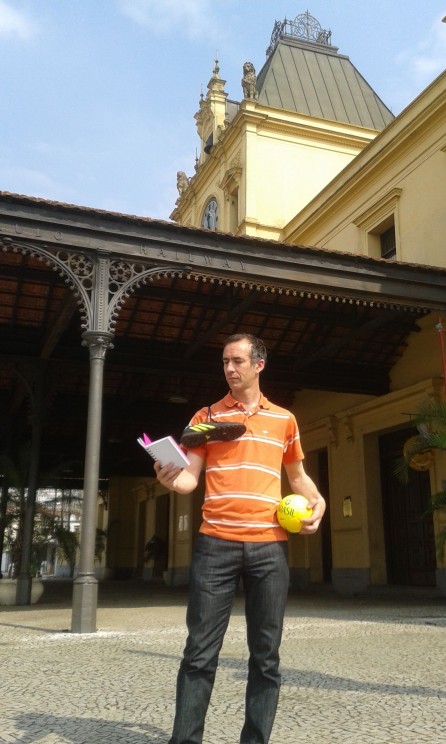
Opposite the passenger terminal, where the photo was taken, an old building is being converted into the Museu do Pelé, to house the history of Santos Futebol Clube’s most famous player, heralded by many as the greatest footballer of the twentieth century – though it will not be ready to open in time for the World Cup. The stories of Miller and Pelé are often linked to illustrate the development of football in Brazil. Gilberto Freyre, the Brazilian sociologist and historian, was one of the first:
‘[It was] Englishmen who introduced into Brazil the principal sporting and recreational replacements for our colonial jousting tournaments: horse-racing, tennis, cycling and football itself, which here became fully naturalised as a game not for fair-haired European expatriates in the tropics but for local people: […] people increasingly of varying shades of brown; with de-Anglicisation culminating in the admirable Pelé, after shining with Leônidas.
[Football] has become a veritable Afro-Brazilian dance, with footwork never imagined by its inventors. Has it stopped being British? Not in the slightest. Association football cannot be separated from its British origins to be considered a Brazilian or Afro-Brazilian invention. What it is, in its current, triumphant expression, is an Anglo-Afro-Brazilian game’. (Gilberto Freyre, The British in Brazil, London, 2011, first published in Portuguese in 1954, p.13.)

Charles Miller was born in São Paulo to a Scottish father and a Brazilian mother whose surname, Fox, reveals her English origins. During his lifetime the population of São Paulo ballooned from around 100,000 in 1874 to well over 2 million in 1953. Most of those new citizens were migrants and their children. São Paulo and Brazil were remaking themselves. Football and music became central ways for Brazilians to express a new inclusive identity after the abolition of slavery (1888) and the establishment of a new republic to replace monarchy (1889).
The sense of Brazilian football leaving its British origins behind as it headed for global domination on and off the pitch, as suggested by Freyre, is why there is no statue or plaque to Miller in the city, not even in the Praça Charles Miller, the square at the front of the Pacembu stadium which houses the Museu do Futebol. Though he was born and died in Brazil, and lived almost his entire life in Brazil (the exception was his schooling in Hampshire, England) Miller’s legend is that of an immigrant, stepping off the ship in Santos to begin a new life. His ambiguous identity, floating between Scottish, British and Brazilian might explain why his simple grave in the Cemeterio de Protestantes in São Paulo is so modest (a cross marked C.W.M, which the director of the cemetery asked me not to photograph, “out of respect”). The Museu Charles Miller, housed in the exclusive Clube Athletico Sao Paulo, and available to visit on appointment, contains old photographs, trophies and a letter from Pelé.
In Brazilian football historiography, “Charles Miller” has become a cipher for the elite, foreign origins of a game which was were subsequently embraced by the Brazilian povo (the people). Something similar is true of Alexander Watson Hutton for Argentina, a more conventional immigrant figure, a Scot who arrived in Buenos Aires as an adult and set about institutionalising and regulating the game of football through schools, teams and leagues. At the II Simpósio Internacional de Estudos Sobre Futebol that I attended in São Paulo last week, Miller was referenced by many of the researchers as a scene-setter to establish their credentials, his name alone enough to conjure images of moustachioed elite white men in blazers tapping a ball around.
At the Simposio, discussing museums and football with Richard McBrearty, director of the Scottish Football Museum, and Daniela Alfonsi, Diretora de Conteudo do Museu de Futebol, Kevin Moore, director of the [English] National Football Museum, noted that Miller’s story is ‘the very epitome of the multinational, global nature of the origins of football’. But they also pointed out that the origins of football were anything but a one man show. Hundreds of people played football in Brazil at the end of the nineteenth century, and historian José Moraes dos Santos Neto has argued pretty convincingly that football was being played in several places in Brazil before Miller’s much-heralded return from England. The ways in which Brazilians took on the game and made it their own is the subject of many wonderful books, including Alex Bellos’ Futebol: The Brazilian Way of Life and David Goldblatt’s Futebol Nation: A Footballing History of Brazil. The importance of Charles Miller lies not in any individual greatness but in the way that his story has captured something of the essence of being Brazilian, and of the ways in which football was adopted, regulated, internationalised and embraced around the world.
Dr Matthew Brown is a reader in Latin American Studies at the University of Bristol, and specialises in the history of sports in South America. In particular, the history of the very first football teams to be established. He contributed the biographies of Charles Miller and Alexander Hutton to Oxford Dictionary of National Biography’s May update.
The Oxford Dictionary of National Biography online is freely available via public libraries across the UK. Libraries offer ‘remote access’ allowing members to log-on to the complete dictionary, for free, from home (or any other computer) twenty-four hours a day. In addition to 58,800 life stories, the ODNB offers a free, twice monthly biography podcast with over 190 life stories now available. You can also sign up for Life of the Day, a topical biography delivered to your inbox, or follow @ODNB on Twitter for people in the news.
Subscribe to the OUPblog via email or RSS.
Subscribe to only history articles on the OUPblog via email or RSS.
Image credits: (1) Matthew Brown arriving in Brazil, impersonating Charles Miller, © Gloria Lanci. (2) Site of the forthcoming Museu do Pelé, © Matthew Brown.
The post Football arrives in Brazil appeared first on OUPblog.

By:
Sue Morris,
on 4/17/2014
Blog:
Kid Lit Reviews
(
Login to Add to MyJacketFlap)
JacketFlap tags:
a changing world,
Abayomi,
Darci Pattison,
forest depletion,
pumas,
Children's Books,
Picture Book,
NonFiction,
Series,
Brazil,
wildlife,
conservation,
wisdom,
5stars,
Mims House,
Library Donated Books,
Kitty Harvill,
Add a tag
 .
.
Abayomi, the Brazilian Puma: The True Story of an Orphaned Cub
by Darci Pattison & Kitty Harvill, illustrator
Mims House 2014
978-1-62944-001-9
Ages 6 to 8 32 pages
.
“From the award-winning team that brought you WISDOM, THE MIDWAY ALBATROSS, comes a new heart-warming story of an orphaned puma cub. A mother puma, an attempt to steal a chicken, and an angry chicken farmer—the search is on for orphaned cubs. Will the scientists be able to find the cubs before their time runs out?
In this “Biography in Text and Art,” Harvill takes original photos as references to create accurate wildlife illustrations. Pattison’s careful research, vetted by scientists in the field, brings to life this true story of an infant cub that must face a complicated world alone—and find a way to survive.”
Opening
“In the far south, in Brazil, a puma cub was born in the early spring month of October 2012.”
The Story
Brazil, once covered by deep forests, now houses more people in cities and villages. To keep their cars moving more sugar plantations took over much of the remaining forest. Pumas, and other wild animals, must live closer to man and find it more difficult to hunt for food. One night, a female puma spotted some chickens in a farmer’s barn. Their normal diet of armadillos, capybaras, and ring-tailed coatis were getting hard to find. The puma needed to feed her cub and the chickens were easy prey. But she fell victim to a farmer’s trap. Before wildlife officials could get to the farm and safely remove the puma, she died.
Alone, hungry, and no mother to help, her cub had to hunt, but would he know how? Wildlife officials followed the mother puma’s trail trying to find her cubs but came up empty. Twenty-three days after his mom left and never returned, dogs a mile away from home cornered the cub. Dehydration and starvation ravished the cub’s body, stealing the energy he needed to walk. He staggered from place to place. This time wild life officials safely caught the cub, naming him Abayomi, which means happy meeting in the Tupi-Guarni native language. Scientists did what was needed so this little guy could return to the wild. Were they successful?

Review
The team of Darci Pattison and Kitty Harvill have made their second successful wildlife children’s book about a fascinating survivor. The first, Wisdom, the Midway Albatross, garnered starred reviews. Abayomi will undoubtedly do the same. With simple language and thoughtful prose, the story of Abayomi will come to life for schoolchildren, many of whom live in urban areas and have never seen a puma. Though the death of the mother puma was most likely gruesome, Pattison wrote,
“. . . She fought back. Once, she hit her head hard against the side of the cage and was dazed. After hours of struggling, she died.”
The illustrations were just as easy on the subject. You see the puma in a cage and some chickens in a roost, but nothing more. Not one spittle of blood mentioned or seen. Children should not experience nightmares after reading Abayomi. All of the illustrations are soft watercolor renditions of actual locations in this true story, completely vetted by experts. Each image is realistic yet gentle on the eyes. The scrawny cub, shown from the backside, does not noticeably display starvation. The hips are noticeably larger due to a lack of abdominal body fat, yet not so much as to scare even the youngest children.

The book concludes with some facts about Abayomi, the Corridor Projects, and urbanization, along with some resources children can look up for more details. Children could write an interesting book report after reading Abayomi the Brazilian Puma. Pattison and Harvill make a splendid team that children, parents, and teachers should not ignore. Conservation and wildlife experts and scientists fact check Pattison’s research. Harvill uses photographs taken on site when painting her illustrations. The pair have made clear choices that make the books assessable to younger children, while still interesting older kids. (Yes, like myself.)
As with Wisdom, the Midway Albatross, Abayomi, the Brazilian Puma should be in school libraries and homeschooling bookshelves that cover wildlife, conservation, or the changing world. As starting points, Abayomi and Wisdom, are great resources for children. While not an expansive missive, these two books will guide students to other resources and further knowledge. The two books also allow younger children to learn about these subjects in a mild, non-scary manner that will peak curiosity, not provoke nightmares.

ABAYOMI, THE BRAZILIAN PUMA: THE TRUE STORY OF AN ORPHANED CUB. Text copyright © 2014 by Darci Pattison. Illustrations copyright © 2014 by Kitty Harvill. Reproduced by permission of the publisher, Mims House, Little Rock, AK.
.
Learn more about Abayomi, the Brazilian Puma HERE.
Get your copy of Abayomi, the Brazilian Puma at Amazon—B&N—Mims House—ask for it at your local bookstore.
.
Meet the author, Darci Pattison, at her website: http://www.darcypattison.com/
Meet the illustrator, Kitty Harvill, at her website: http://www.kharvillarte.com.br/artist.html
Find more Mims House stories at the publisher’s website: http://mimshouse.com/
.
Also by Darci Pattison

Saucy and Bubba, a Hansel and Gretel Tale

Vagabonds
.
.
.
.
.
.Also by Kitty Harvill
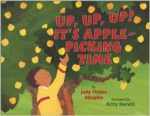
Up, Up, Up! It’s Apple-Picking Time

Vida Livre (published in Brazil)
.
.
.
.
.
Also New from Mims House

The Girl, the Gypsy, and the Gargoyle
.
.

Filed under:
5stars,
Children's Books,
Library Donated Books,
NonFiction,
Picture Book,
Series Tagged:
a changing world,
Abayomi,
Brazil,
conservation,
Darci Pattison,
forest depletion,
Kitty Harvill,
Mims House,
pumas,
wildlife,
wisdom 








By: Maggie Belnap,
on 4/12/2014
Blog:
OUPblog
(
Login to Add to MyJacketFlap)
JacketFlap tags:
infographic,
law enforcement,
*Featured,
victor,
Images & Slideshows,
#Cambodia,
Gary A. Haugen,
Locust Effect,
Victor Boutros,
locust,
boutros,
haugen,
imprisons,
Books,
Law,
Current Affairs,
Brazil,
human rights,
violence,
poverty,
Peru,
Congo,
gary,
Add a tag
The struggle for food, water, and shelter are problems commonly associated with the poor. Not as widely addressed is the violence that surrounds poor communities. Corrupt law enforcement, rape, and slavery (to name a few), separate families, destroys homes, ruins lives, and imprisons the poor in their current situations. Gary A. Haugen and Victor Boutros, authors of The Locust Effect: Why the End of Poverty Requires the End of Violence, have experience in the slums, back alleys, and streets where violence is a living, breathing being — and the work to turn those situations around. Delve into the infographic below and learn how solutions like media coverage and business intervention have begun to positively change countries like the Congo, Cambodia, Peru, and Brazil.
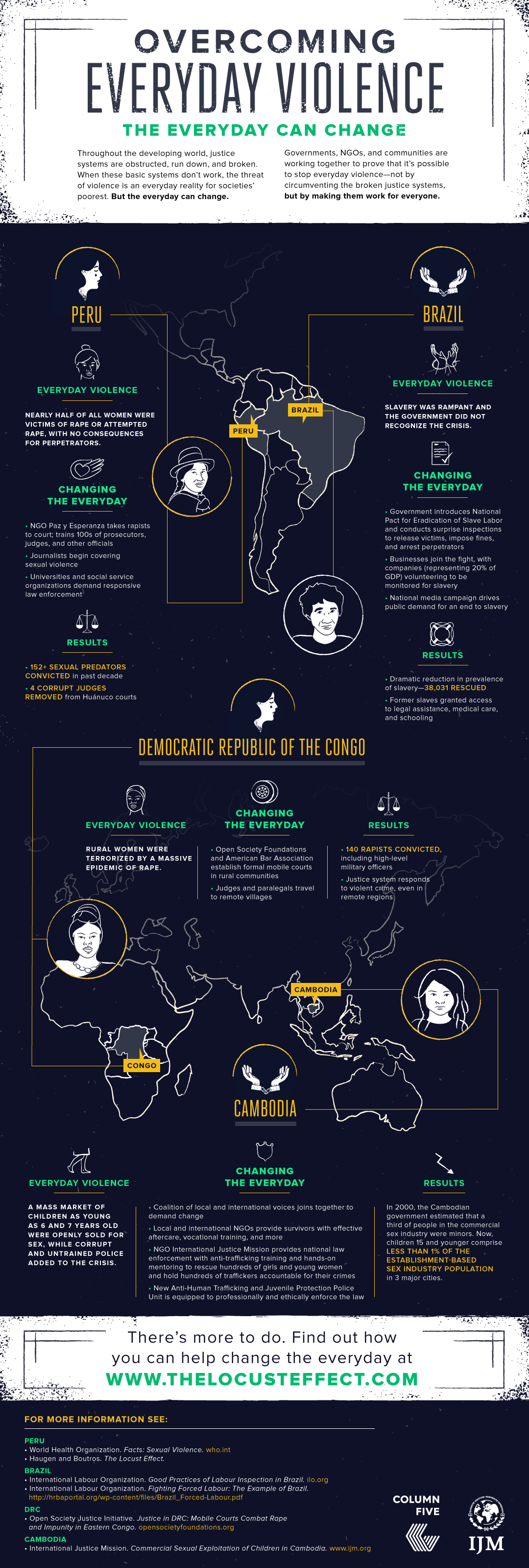
Download a copy of the infographic.
Gary A. Haugen and Victor Boutros are co-authors of The Locust Effect: Why the End of Poverty Requires the End of Violence. Gary Haugen is the founder and president of International Justice Mission, a global human rights agency that protects the poor from violence. The largest organization of its kind, IJM has partnered with law enforcement to rescue thousands of victims of violence. Victor Boutros is a federal prosecutor who investigates and tries nationally significant cases of police misconduct, hate crimes, and international human trafficking around the country on behalf of the U.S. Department of Justice.
Subscribe to the OUPblog via email or RSS.
Subscribe to only current affairs articles on the OUPblog via email .or RSS.
The post Overcoming everyday violence [infographic] appeared first on OUPblog.


By: Jerry Beck,
on 4/3/2014
Blog:
Cartoon Brew
(
Login to Add to MyJacketFlap)
JacketFlap tags:
Feature Film,
Brazil,
Documentary,
Carlos Saldanha,
Fabio Yamaji,
Marcos Magalhaes,
Between Frames,
Between Frames: The Art of Brazilian Animation,
Canal Brasil,
Eduardo Calvet,
Rosana Urbes,
The Kaiser,
Add a tag
When you think of countries that are known for their animation, Brazil is probably not among the first that comes to mind. However, the country has nearly a century-long history of producing animation, and while historically most of the animation they have made hasn't been seen outside of its borders, there have been notable contributions to the art form throughout the country’s history. With the animation industry growing quickly in Brazil—they are ranked seventh for countries that visit Cartoon Brew most often—it is a great time to explore the country's animation legacy.
“He doesn't play football… he’s only drawing, all the time. What’s his problem, Doctor?” Only a specialist can find out… Real animators were asked to give their animated and live action testimonies about their childhood as animators. It is indeed a strange condition...
Read the rest of this post

By: Jerry Beck,
on 3/4/2014
Blog:
Cartoon Brew
(
Login to Add to MyJacketFlap)
JacketFlap tags:
Cartoon Culture,
Carnival,
Brazil,
Cheetara,
Speed Racer,
Muttley,
Sonic the Hedgehog,
The Flash,
Ayrton Senna,
Dick Dastardly,
Penelope Pitstop,
Speedy Gonzales,
Add a tag
Media conglomerates export American culture throughout the world, but other countries often don't consume that culture in its intended manner. Here's a great example: a performance that took place yesterday at Carnival in Rio de Janeiro, Brazil.
The Summer Princeby Alaya Dawn Johnson
June and her best friend Gil are thrilled to wrangle an invite to the official celebration of the newly elected Summer King, Enki. But they never anticipate that Gil and Enki will fall in love, or how much Enki will affect both of their lives. Although the Summer King has no real power, Enki, who comes from the lowest level of society, is determined to use what influence he has to help his people. June and Enki begin to collaborate on a big art installation, one that they hope will both send a message to the city, and win June the Queen's Award. But none of the three can forget that at the end of the summer, Enki will die. Because the real purpose of the Summer King is sacrifice in service of the city.
The Summer Prince is a brilliant book on so many levels. To start, it's an achingly immersive story set in a future Brazil. Added to that are elements from the Sumerian myth
The Epic of Gilgamesh. Going deeper, there are the themes: power and sacrifice, choices and consequences, privilege and class, order and change. Finally, there is the writing: Alaya Dawn Johnson has created a beautiful tapestry so intricately woven that the patterns aren't always obvious on the first read-through. Even on my second read I'm not sure if I saw everything.
Palmares Tres is a gem of a city where past culture and future culture merge. It's a city where people still Samba and eat
Vatapá stew, where
grafeteiros create masterpieces and street gangs fight with
capoeira. And yet it's a city with deep class divisions, where class hierarchy is literally expressed in the city tiers: the higher classes live on the upper levels and the lowest class lives on the bottom tier, where the the stink of the algae vats is ever present. This physical expression of class hierarchy is not a new idea in science fiction, but it's well done here. That stink, known as the Catinga, becomes a powerful symbol in the story, and in fact the higher tiers call the lowest tier "The Catinga."
Palmeres Tres is a city ruled by a matriarchy: a Queen and a council of women called Aunties. Many of them have forgotten the purpose of power, and while they, in their own way, seem to love the city, often their machinations seem designed to protect their own power rather than benefit the city. Most residents of the city live 200 years or more, setting up a situation where anyone under 30 is considered a juvenile, and not to be trusted to make good decisions. So we have class conflict, gender conflict, and age conflict, and with his election as Summer King, Enki becomes the touchstone at the center of all these conflicts.
I've seen this book described as dystopian, but I don't think that it quite falls into that classification. The traditional definition of a dystopia is one that seems utopian on the surface, but is later revealed to be oppressive and deeply flawed. I think that in some ways
The Summer Prince turns that around: the flaws are fairly obvious early on, but as you continue to read it becomes clear how much the citizens of Palmeros Tres love their city with a genuine love, even in spite of the flaws. However,
The Summer Prince is similar enough to dystopian literature that I think it will appeal to teens who enjoy dystopian books.
It's not necessary to be familiar with
The Epic of Gilgamesh or to even recognize those elements are there to enjoy the story, but if you are familiar with the Epic it's a sheer joy to discover the iconic story of Enkidu and Gilgamesh wrestling in the streets transformed into a heart-stopping Samba when Gil and Enki first meet.
The Summer Prince is not really a retelling of the myth, but there are some interesting parallels.
June is an imperfect character who struggles throughout the book to make the right choices. Her dream is to be recognized as a great artist, and when that dream comes into conflict with her awakening social awareness, she doesn't always choose the right thing. She blames her mother for her father's death, and because of that she's mean to her mother. All these things make her a believable, realistic character whom the reader can identify with as she grows through her association with Enki.
The Summer Prince does a great job of representing people who are underrepresented in YA lit. All the residents of Palmeros Tres have skin of varying shades of color, and Enki himself is described as being exceptionally charismatic and with very dark skin. Sexual relationships, both same-sex and opposite-sex, are depicted in a natural, unfettered way that's totally a non-issue. In Palmeros Tres it doesn't seem to matter whom you love.
The Brazilian setting is a refreshing change from books set in European-based settings. I personally loved that the book represented a culture and people that you don't often see in American YA Fiction, but I'd be remiss if I didn't point out
this review of The Summer Prince by a native Brazilian, Ana of The Book Smugglers. I'd encourage you to read the review, but in short, Ana is concerned that the Brazilian cultural elements are not always used accurately, and don't go any deeper than those elements that outsiders identify with Brazil, such as samba, Carnival, and capoeira. To Ana, it feels like a stereotype.
I've been thinking a lot about Ana's review over the last few days. Does the book stereotype Brazilians? Maybe - it's hard for me to know since I'm not Brazilian. Should a writer be able to write about a culture as an outsider to that culture? This, I think, is the crux of the controversy, and I've seen good arguments on both sides. I personally think writers stretching to write about things outside their personal experience is a good thing, because it helps to bring those ideas and cultures to other people who are not familiar with them, but the outsider has to work harder to get it right. I
found an interview with Johnson where she says about her research, "I read a lot of books, particularly about the history of the African diaspora in Brazil. Also got advice from my sister, who studied in Brazil and knew many sources. And sent it to Brazilian writers for help."
I totally understand Ana's frustration and annoyance with the book. It's not quite the same thing, but I studied a martial art for 18 years, and I get really annoyed when I read a fiction book that gets the martial arts details wrong. So I get how frustrating it would be to have your culture portrayed inaccurately. But it does sound like Johnson did try get the details right, and I hope that maybe it will at least it will inspire young people to want to learn more about Brazil and read up on it, as I did after finishing the book. In balance, I think that a book like this that encourages young people to think outside their comfort zone and learn about new ideas and new cultures is a good thing. There are no easy answers, but I think it's important that we keep having these conversations as we try to get it right.
The Summer Prince is the 2013 Cybils Awards winner for the YA Speculative Fiction category.
Who would like this book:
Science fiction and dystopian readers, as well as teens who like reading about other cultures.
Get it from:FTC required disclosure: Review copy sent by the publisher for the purpose of Cybils Awards judging. The bookstore links above are affiliate links, and I earn a very small percentage of any sales made through the links. Neither of these things influenced my review.
By: Grant Overstake,
on 10/25/2013
Blog:
(
Login to Add to MyJacketFlap)
JacketFlap tags:
young adult sports,
Track and Field Stories,
Sue Yeomans,
World Masters Track and Field Championships,
Amazon.com,
Uncategorized,
Kansas,
Brazil,
Girls Sports,
Grant Overstake,
Inspirational Sports Stories,
Maggie Steele,
Maggie Vaults Over the Moon,
Kansas State High School Activities Association,
KSHSAA,
Pole Vault Fiction,
Kansas Farm Life,
Recommended sports books for teens,
Grain Valley,
Allan Williams,
Great Britain Masters,
PORTO ALEGRE,
Add a tag
PORTO ALEGRE, Brazil (Oct. 25) – Storybook heroine Maggie Steele received a huge honor at the World Masters Track and Field Championships, when two gold medal winning pole-vaulters — Allan Williams and Sue Yeomans of Great Britain — paid a special … Continue reading →

By: Kyle Zimmer,
on 9/24/2013
Blog:
First Book
(
Login to Add to MyJacketFlap)
JacketFlap tags:
international,
Literacy,
Books & Reading,
Education,
Book Recipients,
India,
First Book,
global,
Brazil,
Social Entrepreneurship,
Egypt,
Kyle Zimmer,
Volunteers,
Clinton Global Initiative,
social enterprise,
First Book Supporters,
The Stories for All Project,
#CGI2013,
First Book Global,
Add a tag
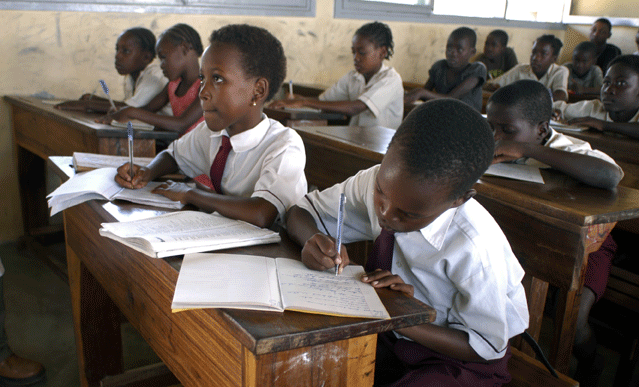
In 2012, Malala Yousafzai, age 15, was shot in the face by Taliban thugs for daring to promote education for women and girls in her native Pakistan. She has not only survived, she has taken her cause to the global level. Her speech before the United Nations inspired the world: “One child, one teacher, one book and one pen can change the world.”

I think of Malala often; her words and the battle she is waging against forces determined to keep her away from a world of knowledge. We know that one child with one book can change the world. But millions of children are being held back from the knowledge they’re so hungry for, not only by violent fundamentalism but by relentless poverty. This is a battle, and we have to win.
That’s why today at the Clinton Global Initiative meeting in New York, I announced First Book’s commitment to reach 10 million children worldwide by 2016 with the books they need to read, learn and succeed.
First Book Global: New Books to Kids At Home and Around the World
Each year, First Book, a nonprofit social enterprise, connects 2 million children from low-income families in the United States and Canada with brand-new, top-quality books and educational materials. Over the next three years, we will expand our efforts globally, reaching classrooms, programs and NGOs in India, Brazil, Egypt and elsewhere.
 Our efforts abroad will strengthen our work domestically. One of our core missions is to bring children here in the United States books and digital content that reflects the full diversity of the world. As we expand the market for books and materials in a range of languages, countries, and cultures, the array of content we can offer in the United States will also grow. More stories will be available to all children.
Our efforts abroad will strengthen our work domestically. One of our core missions is to bring children here in the United States books and digital content that reflects the full diversity of the world. As we expand the market for books and materials in a range of languages, countries, and cultures, the array of content we can offer in the United States will also grow. More stories will be available to all children.
We’ve been preparing for global expansion for a long time. Our team at First Book has already learned from pilot projects around the world with partners including Feed The Children, World Vision and Touch A Life Foundation. We have been in discussions with a variety of potential global partners who are eager to work with us to access new educational resources that have been so scarce for the children they serve.
A Real and Urgent Need
Make no mistake. It will be hard work. The demands on our staff, volunteers and partners will be staggering, and the fundraising needs are daunting.
But we don’t have the luxury of waiting until it’s easy.
Children in poverty around the world are waiting for us, and so are the local heroes working to educate them. They have no supply pipeline for books, calculators, educational games and digital readers. First Book is the missing piece, and they need us now.
Over the next three years, we’ll be building our content, our partnerships and our outreach, and we’ll be asking you to help us fulfill this commitment to children around the world.
Click here to sign up for occasional email updates about First Book and our global expansion, and to learn ways you can get involved.
The post The Power of Children’s Books to Change the World appeared first on First Book Blog.


Beautiful work from Vitor Andrade, a designer and art director based in Sao Paulo, Brazil, currently employed at R/GA.




——————–
Also worth viewing…
Hong Kong Stamps
WTHR App
Robert Sessler
Not signed up for the Grain Edit RSS Feed yet? Give it a try. Its free and yummy.
Share This
RSS Sponsor: Mattson Creative is Hiring!

By: Grant Overstake,
on 7/26/2013
Blog:
(
Login to Add to MyJacketFlap)
JacketFlap tags:
Chile,
Uncategorized,
Canada,
Japan,
Taiwan,
Amazon,
Philippines,
Mexico,
France,
Australia,
India,
Poland,
Germany,
New Zealand,
Pakistan,
Puerto Rico,
Belgium,
Spain,
Slovenia,
United Kingdom,
Finland,
South Africa,
Brazil,
Singapore,
Nicaragua,
Ireland,
Netherlands,
Italy,
Turkey,
Israel,
Switzerland,
Nigeria,
Sweden,
Indonesia,
Mongolia,
Thailand,
Argentina,
Morocco,
Peru,
Jamaica,
Norway,
Egypt,
Indiebound,
Iceland,
Venezuela,
Bahamas,
Denmark,
Greece,
United States,
Portugal,
Czech Republic,
Colombia,
Romania,
Croatia,
Saudi Arabia,
Hong Kong,
Ukraine,
Jordan,
Yemen,
Algeria,
Hungary,
Bermuda,
Ecuador,
Bulgaria,
Estonia,
Tunisia,
Trinidad and Tobago,
Girls Sports,
Bahrain,
Lithuania,
Namibia,
United Arab Emirates,
Grant Overstake,
Inspirational Sports Stories,
Maggie Vaults Over the Moon,
young adult sports,
KSHSAA,
Pole Vault Fiction,
Track and Field Stories,
sports novels,
Recommended sports books for teens,
Watermark Books and Cafe,
Kansas State High School Activities Association Journal,
Austria Botswana,
Insirational Sports Books,
Isle of Man,
Republic of Korea,
Russian Federation,
Add a tag
Maggie Steele, the storybook heroine who vaults over the moon, has been attracting thousands of visitors from around the world. So many visitors, in fact, that she’s using a time zone map to keep track of them all.* People are … Continue reading →
New York-based Brazilian filmmaker Guilherme Marcondes (Tyger, Into Pieces) is prepping a new ten-minute mixed-media short Caveirão for release this fall:
Shot in São Paulo, ‘Caveirão’ imagines the secret night activities of that city’s spirits. Inspired by the darker side of Brazilian pop culture, the film crosses over genres and techniques. Fantasy, horror and cartoon meet through live-action, 2D animation and 3D VFX. This is the first film from The Master’s Voice project about ghost stories based on urban folklore.
‘Caveirão’ literally means ‘Big Skull’. Besides obviously addressing the main character’s features, the name has few of connotations in Brazil. It nicknames the armored policecar that goes up the favela hills to terrorize drug-dealers (and the whole population living there). You would also use the word ‘caveira’ (skull) in everyday language as an adjective for something evil or ominous. At the same time, despite the dark imagery it conjures, ‘Big Skull’ sounds as goofy as a monster from a Scooby-Doo cartoon. That irony was certainly not lost when I chose ‘Caveirão’ as the name of my film.
Follow Guilherme’s new Facebook page for behind-the-scenes footage, animation tests, and updates on the film.

Brew reader Leo Santos introduced me to the fantastic work of Brazilian animator Daniel Og, who animated this series of eight 30-second spots for Canal Futura—one for each of the UN’s Millennium Development Goals:
- Eradicating extreme poverty and hunger,
- Achieving universal primary education,
- Promoting gender equality and empowering women,
- Reducing child mortality rates,
- Improving maternal health,
- Combating HIV/AIDS, malaria, and other diseases,
- Ensuring environmental sustainability, and
- Developing a global partnership for development.
Og’s eccentric animation style tweaks the conventional patterns of movement. His characters jolt around the screen with an aggressive staccato edge, and everything’s just a little wobbly, but make no mistake, it’s skillful artistry done for effect.
After seeing these spots, I checked out Og’s reel, and while there are hints of the individualistic quirks that make these commercials special, it’s clear that Og’s creativity flourishes most when he works within his personal funky contour-line drawing style. Here’s hoping we get to see a lot more of that because it’s quite unique.

By: Jerry Beck,
on 10/29/2012
Blog:
Cartoon Brew
(
Login to Add to MyJacketFlap)
JacketFlap tags:
UK,
Brazil,
Sweden,
Michael Schlingmann,
Lobo,
Animated Fragments,
Matt Abbiss,
Adam Dedman,
Alexander Pettersson,
Add a tag
It’s been a while since the last installment of Animated Fragments so here’s another random assortment of short animation tests, exercises and other brief pieces that I’ve run across recently:
AD by Adam Dedman (UK)
Bassawards “Call for Entries” spot by Lobo (Brazil)
Animated walks and runs by Michael Schlingmann (UK)
“Cuckoo” by Alexander Pettersson (Sweden)
Run Cycle by Matt Abbiss (UK)
O Rei Gastão (King Gaston) by Rio de Janeiro-based animator Diogo Viegas picked up the best children’s animation award at this year’s Anima Mundi festival. It’s easy to see why: the animation, design and color are undeniably charming. There’s English captions for non-Portuguese speakers, but the visual storytelling is so clear that I found it just as charming (if not moreso) when I didn’t understand the lyrics.
Cartoon Brew |
Permalink |
No comment |
Post tags: Brazil, Diogo Viegas, Toon Boom
Brazilian artist Jomário Murta used multiple Microsoft Kinects to generate a sequence of point clouds (a set of points in 3D space) as reference for creating animation. The process is akin to motion capture, but not the same:
This is something like animating over the videos. Just like we usually do as reference for timing and more complex movements. The difference is that I can animate three-dimensionally “inside” the video; the advantage instead of mocap is that the animation process is more free, where I can easily exaggerate the movements and play a lot with the poses without compromising my style of animation.
Murta admits that he is still in a research phase and hasn’t figured out any practical applications for the technique, but that’s to be expected of any exploration of a new technology. The results are promising thus far, and it’ll be interesting to see how he and others build on the process.
Cartoon Brew |
Permalink |
No comment |
Post tags: Brazil, Jomário Murta, Kinect, motion capture
All I can say about this short is: “Wow!” Pure eye candy (and a tad NSFW) from Alessandro Corrêa in Brazil:
Cartoon Brew |
Permalink |
No comment |
Post tags: Alessandro Corrêa, Brazil
Festivals rarely make animated spots to encourage film submissions, much less spots that are as cool as the one above. The piece was created by Diego Akel to encourage filmmakers to submit to the MUMIA Underground World Animation Festival. The festival, which is celebrating its 10th edition this fall, screens in various Brazilian cities including Belo Horizonte, Betim and Nova Lima.
If I understood their submission rules correctly, they also have an awesomely renegade film selection process: “There will not be selection of the films and videos submitted. As long as four hours of the festival programming is completed, the selection will be over.” If you’re interested in showing your film at MUMIA, go here for submission details. Entries need to be postmarked by May 31.
Cartoon Brew |
Permalink |
No comment |
Post tags: Brazil, MUMIA Underground World Animation Festival

By: Jerry Beck,
on 3/30/2012
Blog:
Cartoon Brew
(
Login to Add to MyJacketFlap)
JacketFlap tags:
US,
Germany,
Brazil,
Bulgaria,
Josh Parpan,
Animated Fragments,
Flavio Santana,
FuFu Frauenwahl,
Nicole M. Hamilton,
Svilen Dimitrov,
Add a tag
Goodbye by Flavio Santana (Brazil): This piece was the winner of February’s edition of the 11 Second Club.
Test by Josh Parpan (US)
Little Red Bumper by Nicole M. Hamilton (US)
Animated GIF by FuFu Frauenwahl (Germany)

Excerpt from The Long Walk by Svilen Dimitrov (Bulgaria)
Cartoon Brew |
Permalink |
No comment |
Post tags: Brazil, Bulgaria, Flavio Santana, FuFu Frauenwahl, Germany, Josh Parpan, Nicole M. Hamilton, Svilen Dimitrov, US
When done well, the tactile quality of stop motion is one of the true joys of animation. I can’t take my eyes off of this beautifully articulated and brilliantly caricatured stop motion animation of Sigmund Freud created by Rio de Janeiro-based Luciano do Amaral. More impressive, Stop Motion Works suggests that the animation was achieved primarily through low-tech means with no jointed facial armature mechanisms, computer printed facial masks, or cable controls. Bear in mind, there’s a few wires and greenscreens in the video above because the animation was later composited into a TV mini-series called Afinal,o que querem as mulheres?, a show that I know absolutely nothing about except that it’s better than anything on American TV.
Cartoon Brew |
Permalink |
No comment |
Post tags: Brazil, Luciano do Amaral, Sigmund Freud

By: Alice,
on 1/26/2012
Blog:
OUPblog
(
Login to Add to MyJacketFlap)
JacketFlap tags:
exploration,
*Featured,
higher education,
New World,
this day in world history,
Vincente Yáñez Pinzón,
pinzón’s,
pinzón,
vincente,
martín’s,
martín,
History,
spain,
Brazil,
This Day in History,
Latin America,
Europe,
sailed,
Add a tag
This Day in World History
January 26, 1500
Pinzón Becomes First European to Land in Brazil
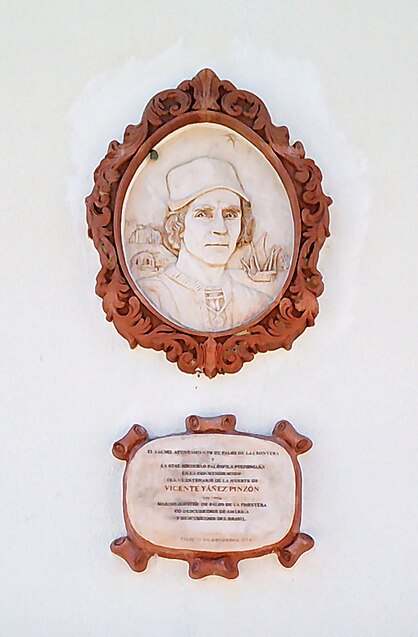 On January 26, 1500, Spanish sailor Vincente Yáñez Pinzón spotted land. He named the cape the Cabo de Santa María de la Consolación. The site was near modern-day Recife, Brazil, making Pinzón the first European to explore Brazil.
On January 26, 1500, Spanish sailor Vincente Yáñez Pinzón spotted land. He named the cape the Cabo de Santa María de la Consolación. The site was near modern-day Recife, Brazil, making Pinzón the first European to explore Brazil.
Pinzón was an accomplished navigator who had taken part in the famous 1492 voyage of Christopher Columbus. Pinzón commanded the Niña while his brother Martín commanded the Pinta (a third brother, Francisco, was Martín’s chief officer on that ship). It was not until 1499, however, that Pinzón set out on a new expedition.
In November of that year, he sailed from Palos, Spain, reaching the South American coast by the next January. He spent several months exploring the coast, reaching as far north as the mouth of the Amazon River. Pinzón noticed that the color of the water had changed and, after sampling that differently color water, found it to be freshwater, and not saltwater. He named the body the Mar Dulce, or Sweetwater Sea, and using the strength of the outflowing current, he sailed for the West Indies before returning to Spain.
Records and maps from the Age of Exploration are not always clear or without controversy. Pinzón’s sighting of Brazil is subject to these uncertainties. Some historians think that he landed in Venezuela, not Brazil, and encountered the Orinoco River, not the Amazon. They believe that Portuguese explorer Pedro Álvares Cabral—who certainly reached Brazil in April of 1500—was the first European to land there. At any rate, Portugal, not Spain, gained possession of Brazil and made it the cornerstone of its American empire.
“This Day in World History” is brought to you by USA Higher Education.
You can subscribe to these posts via RSS or receive them by email.


.jpeg?picon=3225)
By: Andi Brown,
on 5/17/2011
Blog:
Writer's Cramps
(
Login to Add to MyJacketFlap)
JacketFlap tags:
pets,
animals,
ego,
Brazil,
authonomy,
animal shelter,
voluntourism,
volunteer vacations,
animal crackers,
Add a tag
I must have an ego the size of a walnut. In the interest of expanding it to peach-size, I have entered two popularity contests.
In my quest to enjoy a vacation of hard labor in Brazil, I began in 47th place (out of 70 contestants) and have worked my way up to 22nd. Go friends and family who vote for me daily!!!!
My novel ANIMAL CRACKER now appears on authonomy.com. I began life there at 3700 and I'm now up to 1100. If I reach the top, Harper Collins, which owns the site, will take a look. So, if you care to drop in on the authonomy site and see a very different version of my prose style, feel free.

architizer:
Painting Urbanism is an exhibit opening Saturday at Storefront in NYC - it examines the work of Haas&Hahn, Dutch artists who paint large-scale murals in Brazil’s poorest urban communities.
I want to live in this neighbourhood. Read more about it on Haas&Hahn’s website, where you’ll also find a huge panoramic JPG shot of the scene above. Stunning.

View Next 25 Posts




















 Our efforts abroad will strengthen our work domestically. One of our core missions is to bring children here in the United States books and digital content that reflects the full diversity of the world. As we expand the market for books and materials in a range of languages, countries, and cultures, the array of content we can offer in the United States will also grow. More stories will be available to all children.
Our efforts abroad will strengthen our work domestically. One of our core missions is to bring children here in the United States books and digital content that reflects the full diversity of the world. As we expand the market for books and materials in a range of languages, countries, and cultures, the array of content we can offer in the United States will also grow. More stories will be available to all children.









A couple more excellent endorsements, Grant. Nice going! BTW, I think “Maggie” is also now available in Mexico.